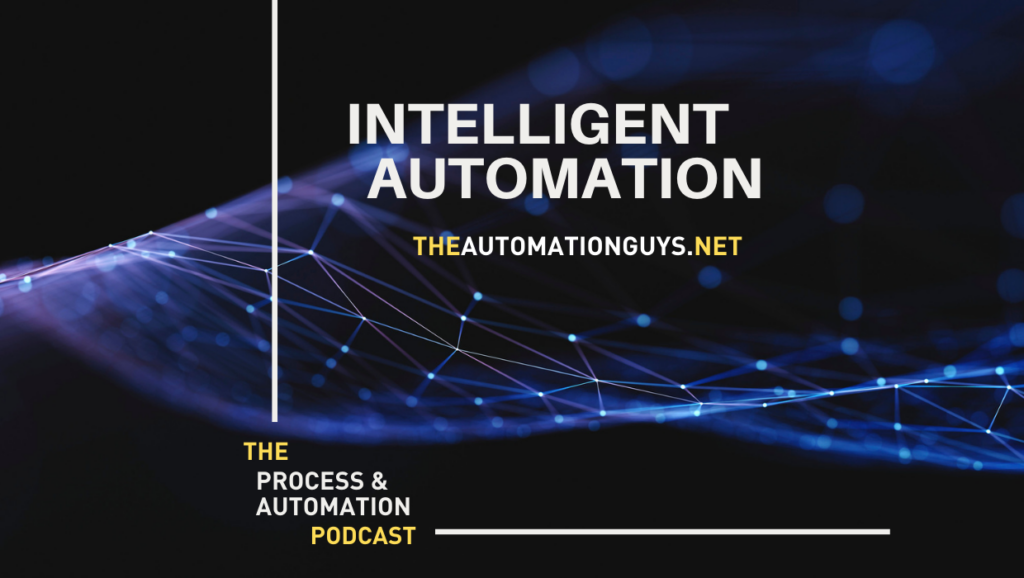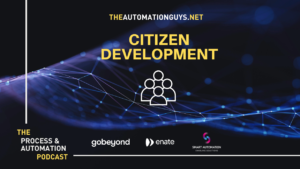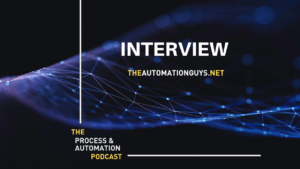Blog

What are the cost benefits of Low-Code vs. Traditional App Development? In Part 2 of the 2-part episode of the Process and Automation podcast you will find out exactely this and why you should consider starting your low code journey today!
Share This Post
Start here –> https://theautomationguys.net
Do you have any questions? Would you like to give us feedback? Are you interested in workshops on the topic of automation? Are you an expert in the field of automation and would like to be on the podcast?
LinkedIn Arno: https://bit.ly/3aABArd
LinkedIn Sascha: https://bit.ly/36Jd31T
Velocity-IT: https://www.velocity-it.com/about-us/
convedo Group: https://www.convedo.com/about-us
Episode Transcript
Yeah, and it’s not necessarily, so obviously cost is always a factor we want to look at other than keys, as you mentioned to look at the right things. Um, and to make sure that the, the pipeline is for, for these kind of initiatives. Um, this is where we, for example, bring in process mining, isn’t it to find out in what areas of the business is the potential.
Um, very often if you ask each department, everyone comes up with an idea or several ideas because they know where the pain is. So on a, on a daily basis, they know they’re doing stupid copy and paste like four hours a week. So if you multiply it as, uh, Um, uh, several was several departments, several regions and, uh, entities are kind of stuff adds up very quickly.
And we probably shouldn’t talk about pricing too much. Sure. You have to look at it, but very often the value, um, advice that anyway, so. But initially, I guess you have to look at, uh, do your math and calculate all that stuff. Um, yeah. And it is very useful to find a really high-impact, uh, opportunities and develop this pipeline, uh, either for this low code app development candidates or even software robotics as RPA candidates.
Um, yeah, there’s so many, so many areas costs is obviously one thing, but you can also look at it. Well, how much more could the business. Perform could the business do without looking at the cost of staff, you could look at it as if we put this in place and get this problem solved and all these problems solved.
How much more capacity do we have for for more? Um, can we do 10 times more output potentially by doing good end to end automation? Are we one of the businesses who achieve 80% end to end automation? Um, uh, if you look at it, uh, most businesses, it is, you have to pretend. Um, but you need the, yeah. You need to visibility.
Um, and process mining is one aspect, I guess. Um, more and more companies are looking at. Yeah, definitely. Um, uh, uh, something to analyze during the discovery phase. Um, and when setting up your sort of. Uh, potentially your center of excellence is so, so this, this is all what they are doing day in, day out generally to find, to find good candidates and opportunities within the business.
Um, and then, yeah, we shouldn’t talk about too much about, is cost, I guess, cost value. Usually it should, should outweigh you 10 X, 20 X. Yeah, but I, I think, you know, for me, it’s, uh, we always talk about innovation with insight, a business, and innovation means a lot of things to a lot of people, but I think innovation could be something very small, like, um, automating a very simple manual process now for one person.
Possibly, it’s not too innovative, but for another person that has to deal with a lot of manual processes where emails get fired at them. And they have to deal with a lot of emails with inside their, uh, inbox and put emails in different folders. That’s quite innovative if, if there’s an opportunity for them to, to automate a process where.
Um, you know, invoices arrives, they, uh, created a small little process that, um, can, you know, take those invoices, attach it to a case or two to workflow, route that for approval. Um, and then all of a sudden, you know, you’ve got a business process that’s automated that you can have some interesting metrics, you know, the thing is, um, and that’s innovative, right?
You know, a scenario like that, doesn’t take long to implement in low code and it, you know, it doesn’t take a technical person, for example, to be able to automate that, you know, that something quite straight forward with, with these. Products, if you take that a step further and you say, well, within scientist’s process, um, I have got double keying information of information from the invoice to the finance system, or maybe that’s the part that there is a, uh, a gap for a robot to be plugged in.
You know, we’ve dealt with this approval business. Now we can actually, for this particular task where the, the invoice gets captured in our finance system, train the robot to do that, plug that into your process. Now, all of a sudden you’ve got, um, you know, uh, a process that’s, you know, tenfold better because you can scale now, you know, no matter how many invoices come in, you could quickly, um, Uh, managed them.
You could send them for approval and you’ve got a robot that does the keying in, into your backend system. And again, that’s innovative. It’s, it’s only a small example, scale scale that across the business. Um, you know, they, there could be a lot of these innovative ideas that really makes a big difference.
The, the sum of all of it. And I think that that’s the key of these, these, these low-code platforms not to, um, you know, take these great ideas, throw them at it. It is busy and it sort of just goes into the realms of a backlog somewhere and it takes long to implement it. You know, we want to expedite that innovation and, and provide people the tools to actually go and innovate themselves.
And when they actually arrive at these, these innovative. Let’s say lighter touch point solutions that solve problems for them. If that they needs to, um, you know, go to it because it’s becoming something that becomes key to a business. Um, at least you’ve got something functional. At least you’ve got something that’s already saving time.
All you then need to do is have that discussion with it and say, we want this as a managed. Application now, um, because we can’t afford for this thing to be down. Can you guys help us? We’ve used very standard low-code platforms. We haven’t done something, um, out of the ordinary here. Um, this is not something that is totally crazy.
Um, it is just using normal technology. That’s, you know, from, from, from, from vendors that is quite transparent, it’s easily manageable, easily supportable. Um, Take that into your, uh, support kind of, uh, I guess, uh, process and make sure it runs. And, and, and, and, and continue on that track, you know, allow people to innovate with inside the business.
Absolutely. Yeah. And I think only on that approach will allow, um, uh, we’ll make sure they are not just coming up with some weird solutions, isn’t it? So that, that would be the downside. If you have very strict as it, they still have the problem to solve it is not solving it. At some point I become very, um, everyone becomes very inventive, uh, and this, uh, I think being inventive means, or meant, the shadow, it, we, we talked about this earlier.
So people had servers, uh, under, under their desk running sort of business critical stuff. And then, um, that a person moves on into another position or so, and no one knows that there’s a server and then suddenly these ID requests coming in and it just freaks out.
And so what is this? We have a business critical application here somewhere. And if they come up, was this a. Sort of like a good partnership, a bit of a governance, a few set of rules and otherwise, yeah, he has a good platform. You can, uh, you can do stuff here. It’s nicely in boundaries. And then, uh, everyone, everyone really?
Yeah. Can, can. And it’s nothing here. I think there’s nothing new year. I think that the boundaries of opportunity has just shifted quite a lot. Um, you know, if, if we look at, for instance at the Microsoft power automotive platform, um, That provides eat, eat as much as you want automation to a variety of business users and it’s within sight.
Um, you know, the governance of what the power automated platform provides you. So it’s very easy for me to create a Microsoft flow. When email arrives. I could look at that email, look at the contents of the email and kick off a float at this specific things. So what we talking about here in terms of governance and creating these apps, it’s nothing new.
Um, it, it is already there. Um, you know, I think the point here is that it’s just sort of raising that awareness that, um, you know, these platforms exists. Um, you know, people could use these platforms to. Uh, self sort of diagnose and implement problems and do so quickly. And you know, it doesn’t have to be very sort of elaborate type solution, enterprise grade things.
It is problems that solves issues with inside your department, for example, um, and you know, Uh, most of the low-code platforms, if not all provides those governance around security, data protection, um, you know, release management, scalability, so that that’s all assumed. So all it provides you is this ability to create these, these applications very quickly.
And it opens that up to the masses. Right. And I think sometimes that’s, that’s kind of a bit overlooked. Um, you know, where. We, um, you know, we look at a problem, um, On the surface, it looks like we need to engage a development team, but that’s not always the case. Right. For, for, let’s say for example, a simple supplier onboarding the supplier onboarding as a form, you fill it out.
Um, it goes for a view credit checking. Um, it might then, uh, send the questionnaire back to the supplier to touch some, uh, doc, uh, some documentation as to their compliancy. Uh, maybe some insurance they’ve got liability insurance. It goes back to the team. Once it’s done, it gets persisted in a back office system.
Now all of that is possible. Um, In a low-code world by using, uh, a citizen developer, because all you’re really doing is you’re creating a digital form. You’re stringing together workflow. You’re creating a DocuSign integration perhaps for your electronic signature. And you’ve got a bit of RPA that integrates with a back office system.
And, you know, if you have quite a large. Volume of suppliers that you onboard a simple solution like this compared to like, let’s say an Excel based solution where a supplier onboarding is go to a centralized inbox. Somebody logs it in Excel spreadsheets so they can keep track of it. You know, it’s a hundred fold better because aid centralized, it’s not dark data somewhere in Excel where somebody needs to know how to update stuff.
And you know, that, that’s the sort of thing that we’re talking about here. Yeah, tremendous, uh, opportunities for every year, for every business to, to really, to really look at. And, um, yeah, we say it in, in plenty of our episodes gave you on this, um, uh, journey already or started the journey or very interested to start the journey.
Arno and I are here for you. So if you have any questions on the local topic, in any other, uh, automation topics, you can visit our website, the automationguys.net. There you can, just connect with us or find us on all the social social channels. And we have all the partnerships, so we are very brought in partnerships.
We have not focused on just one technology. So if you, if you need sort of some, some advice on what is the. Approach. What is the right technology, the right vendor for that? Um, I think we, um, yeah, we have a lots of, uh, lots of experience and I’m happy to advise there and, um, we can get you as a partner, get you started on, on, on some, some really good trial packages.
You probably wouldn’t get otherwise. So you have reached out to us and we can set you up. There was, was trials. Get you started on that journey. Um, on anything, anything you’d like to add? Um, no, and I think like I can just echo what Sasha said. Um, you know, reach out to us. I think that, um, you know, Part of what we do is to look at problems and to size it up.
And to understand if you come to us with a problem, we can very quickly provide you an estimate how that would potentially look like in, in low code. And I can guarantee you compared to conventional development, that number will be far lower. And conventional development. And of course the implementation timeframes will be far less than conventional development as well.
So, you know, I would invite our listeners to an almost challenged them to, to bring these problems, to ask these business problems. They have. And, you know, we, we could look at that and really explored what that would take to implement with inside a low-code platform, just to give you that different perspective and a different view of, you know, what automation, um, you know, uh, can cost for your business, but also what value it brings and how quickly you could do that.
Um, and also, you know, just to sort of contrast that against your conventional. Approaches, um, you know, we, we, we are, um, obviously worked very closely with, with, with customers that, that brings us these problems every day. So it’s second nature for us to, to provide these estimates. And we know that’s important to, to bring these estimates into business cases.
Um, you know, so it, it is a place where we can help if, if, if you’re looking at your next automation project and, and the costings around it, and sort of the benefits it provides your business, you know, we, we can help with all of that. Yeah, thank you very much, Ana um, yeah, another, another session on, on low code.
Um, so we have plenty of episodes on our podcasts if you’re not a regular follower or subscriber yet, um, you know, um, I recommend you subscribe to this podcast. Lots of really good stuff coming out every week. Um, yeah. Um, and that will be it for today.
Thank you very much for listening. Unfortunately, that’s it again with this episode of the process and automation podcast, if you liked this episode, please give us a five-star rating and don’t forget to subscribe to this podcast, so you don’t miss any upcoming episode. We hope you will tune in next time. And until then let’s automate it.
- May 26, 2021
- 9:11 pm


